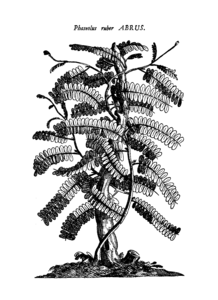Abrus precatorius
Abrus precatorius L.
| Ordre | Fabales |
|---|---|
| Famille | Fabaceae |
| Genre | Abrus |
2n =
Origine : aire d'origine
sauvage ou cultivé
| Français | ' |
|---|---|
| Anglais | ' |
- médicinal ; toxique :
une seule graine est mortelle - graines utilisées pour des colliers
Sommaire
Description
Noms populaires
| français | |
| anglais | |
| portugais | jequiriti (Pharma. Guyane) |
| créole guyanais | ti panacoco [ti-pannakoko] (Pharma. Guyane) |
| palikur | wanaku ihipinõ (Pharma. Guyane) |
Classification
Abrus precatorius L. (1767)
synonyme :
- Glycine abrus L. (1753)
Cultivars
Histoire
Abrus Alpin 1735, De Plantis Aegypti, 32r ; 40
Usages
Coral-bead lant. Love pea. Red-bead vine. Rosary-pea tree. Wild licorice. A plant common within the tropics in the Old World, principally upon the shores. The beauty of the seeds, their use as beads and for necklaces, and their nourishing qualities, have combined to scatter the plant[1]. The seeds are used in Egypt as a pulse, but Don[2] says they are the hardest and most indigestible of all the pea tribe. Brandis[3] says the root is a poor substitute for licorice.
Since long time used by the people in Africa, S and SE Asia and introduced by the slave trade also in America as folkmedicinal plant (leaves, seeds, roots), for this purpose, also for the sweetening glycyrrhizine of the leaves cultivated sporadically in homegardens. It has been tried as cover crop, in E Africa it is grown as magical plant and very frequently as ornamental climber (even in Europe since the 16th cent.). The seeds are used for necklaces and rosaries, in Asia as weight standard for goldsmiths.
Références
- Grenand, Pierre ; Moretti, Christian ; Jacquemin, Henri & Prévost, Marie-Françoise, 2004. Pharmacopées traditionnelles en Guyane. Créoles, Wayãpi, Palikur. 2e édition revue et complétée. Paris, IRD. 816 p. (1ère éd.: 1987). Voir sur Pl@ntUse.

